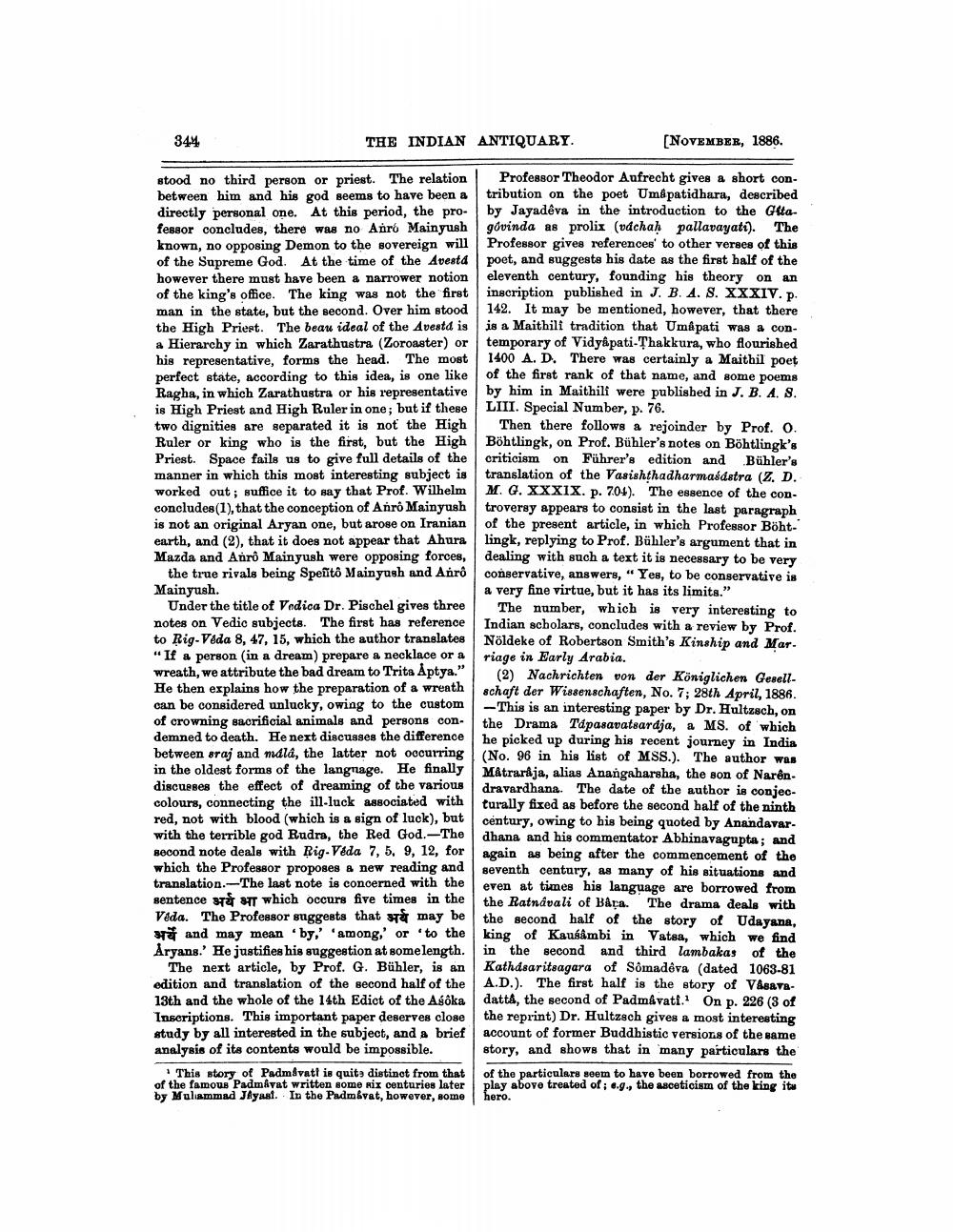________________
344
THE INDIAN ANTIQUARY.
[NOVEMBER, 1886.
stood no third person or priest. The relation | Professor Theodor Aufrecht gives a short conbetween him and his god seems to have been a tribution on the poet Umepatidhara, described directly personal one. At this period, the pro- by Jayadeva in the introduction to the Gitafessor concludes, there was no Anró Main yush govinda as prolix (vdchah pallavayatt). The known, no opposing Demon to the sovereign will | Professor gives references' to other verses of this of the Supreme God. At the time of the Avesta poet, and suggests his date as the first half of the however there must have been a narrower notion eleventh century, founding his theory on an of the king's office. The king was not the first inscription published in J. B. A. S. XXXIV. p. man in the state, but the second. Over him stood 142. It may be mentioned, however, that there the High Priest. The bear ideal of the Avesta is is a Maithili tradition that Um&pati was a cona Hierarchy in which Zarathustra (Zoroaster) or temporary of Vidy&pati-Thakkura, who flourished his representative, forms the head. The most 1400 A.D. There was certainly a Maithil poet perfect state, according to this idea, is one like of the first rank of that name, and some poems Ragha, in which Zarathustra or his representative by him in Maithili were published in J. B. A. S. is High Priest and High Ruler in one; but if these LIII. Special Number, p. 76. two dignities are separated it is not the High Then there follows a rejoinder by Prof. 0. Ruler or king who is the first, but the High Böhtlingk, on Prof. Bühler's notes on Böhtlingk's Priest. Space fails us to give full details of the criticism on Führer's edition and Bühler's manner in which this most interesting subject is translation of the Vasishthadharmasdetra (Z. D. worked out; suffice it to say that Prof. Wilhelm M. G. XXXIX. p. 70+). The essence of the conconcludes(1), that the conception of Anro Mainyush troversy appears to consist in the last paragraph is not an original Aryan one, but arose on Iranian of the present article, in which Professor Böhtearth, and (2), that it does not appear that Ahura lingk, replying to Prof. Bühler's argument that in Mazda and Anrô Mainyush were opposing forces, dealing with such a text it is necessary to be very
the true rivals being Spesito Mainyash and Anro conservative, answers, “ Yes, to be conservative is Mainyush.
a very fine virtue, but it has its limita." Under the title of Vedica Dr. Pischel gives three The number, which is very interesting to notes on Vedic subjects. The first has reference Indian scholars, concludes with a review by Prof. to Rig Veda 8, 47, 15, which the author translates Nöldeke of Robertson Smith's Kinship and Mar. "If a person (in a dream) prepare a necklace or a riage in Early Arabia. wreath, we attribute the bad dream to Trita Aptya."
(2) Nachrichten von der Königlichen GesellHe then explains how the preparation of a wreath schaft der Wissenschaften, No. 7; 28th April, 1886. can be considered unlucky, owing to the custom -This is an interesting paper by Dr. Hultzsch, on of crowning sacrificial animals and persons con- the Drama Tápasavatsardja, a MS. of which demned to death. He next discusses the difference he picked up during his recent journey in India between arai and mdia, the latter not occurring (No. 96 in his list of MSS.). The author was in the oldest forms of the langnage. He finally MAtrarája, alias Anangaharsha, the son of Narên. discuss the effect of dreaming of the various dravardhana. The date of the author is conjeccolours, connecting the ill-luck associated with turally fixed as before the second half of the ninth red, not with blood (which is a sign of luck), but century, owing to his being quoted by Anandavar. with the terrible god Rudra, the Red God. The dhana and his commentator Abhinavagupta; and second note deals with Rig Veda 7, 5, 9, 12, for again as being after the commencement of the which the Professor proposes a new reading and seventh century, as many of his situations and translation.-The last note is concerned with the even at times his language are borrowed from sentence a sT which occurs five times in the the Ratnávali of Bára. The drama deals with Voda. The Professor suggests that så may be the second half of the story of Udayana,
rät and may mean by,' 'among,' or to the king of Kausâmbi in Vatea, which we find Aryans.' He justifies his suggestion at some length. in the second and third lambakas of the
The next article, by Prof. G. Bühler, is an Kathdsaritsagara of Sômadeva (dated 1063-81 edition and translation of the second half of the A.D.). The first half is the story of V&save13th and the whole of the 14th Edict of the Agoka datta, the second of Padmavati. On p. 226 (3 of Inscriptions. This important paper deserves close the reprint) Dr. Hultzsch gives a most interesting study by all interested in the subject, and a brief account of former Buddhistic versions of the same analysis of its contents would be impossible. story, and shows that in many particulars the
This story of PadmSvatt is quite distinct from that of the particulars seem to have been borrowed from the of the famous Padmvat written some Rix centuries later play above treated of: 6.9., the asceticism of the king itu by Muliammad JAyasi. In the Padmavat, however, some hero.




